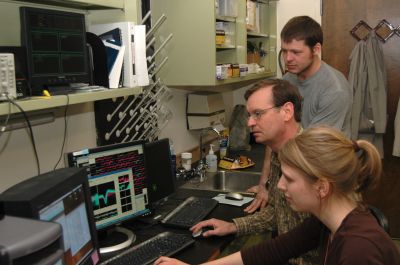Lee Miller ’80

Lee Miller is leading cutting-edge research to restore lost limb movement. He uses surgically implanted electronics and signal processing systems to help people regain mobility after spinal cord injuries or amputations.
Luke Skywalker may have gotten his bionic arm “in a galaxy far, far away,” but Lee E. Miller ’80 is leading cutting-edge research to restore lost limb movement no farther away than Chicago. Miller uses advanced surgically implanted electronics and signal processing systems with a goal of helping people regain mobility and independence after spinal cord injuries or amputations.
Miller, who earned a master’s degree in biomedical engineering and a Ph.D. in physiology from Northwestern University, is a professor of physiology in Northwestern’s Feinberg School of Medicine. He holds a primary appointment in the Department of Physiology and a secondary appointment in the Department of Physical Medicine and Rehabilitation. Northwestern’s Board of Trustees recently named Miller the Edgar C. Stuntz Distinguished Professor of Neuroscience (an endowed professorship) in recognition of his research, publications, teaching and stature in the field.
In his Miller Laboratory of Limb Motor Control, Miller and his post-doctoral fellows, graduate students, and research technicians conduct research in the emerging and highly interdisciplinary field of neural engineering. Miller directs laboratory efforts and international collaborations that seek to understand the nature of the signals within the brain that control arm movements to someday restore movement and limb sensation to paralyzed patients and amputees.
Miller’s lab is engaged in a new field of research within neural engineering – the development of a “Brain Machine Interface (BMI)” – that seeks to meld mind and machine. He’s developing a BMI that could restore control to the paralyzed muscles of a spinal cord injured patient by using brain recordings and computers to bypass the injury and directly activate the muscles through electrical stimulation. In a closely related project, Miller and his team activate tiny regions of the brain electrically in an effort to restore the sense of touch and limb position lost as a result of the injury.
Miller often returns to Goshen College, where he earned his bachelor’s degree in physics, to lecture in science division-sponsored forums about his research. He’s also found a way to bring the college to his lab: he has hired five GC science graduates as technicians – Klaus Huebert ’99, Luke Jordan ’02, Matthew Bauman ’06, Rebecca Friesen ’09 and David Bontrager ’08. “They’ve been uniformly terrific. My faculty colleagues are jealous of my steady supply of great technicians,” Miller said.
– By Richard R. Aguirre




